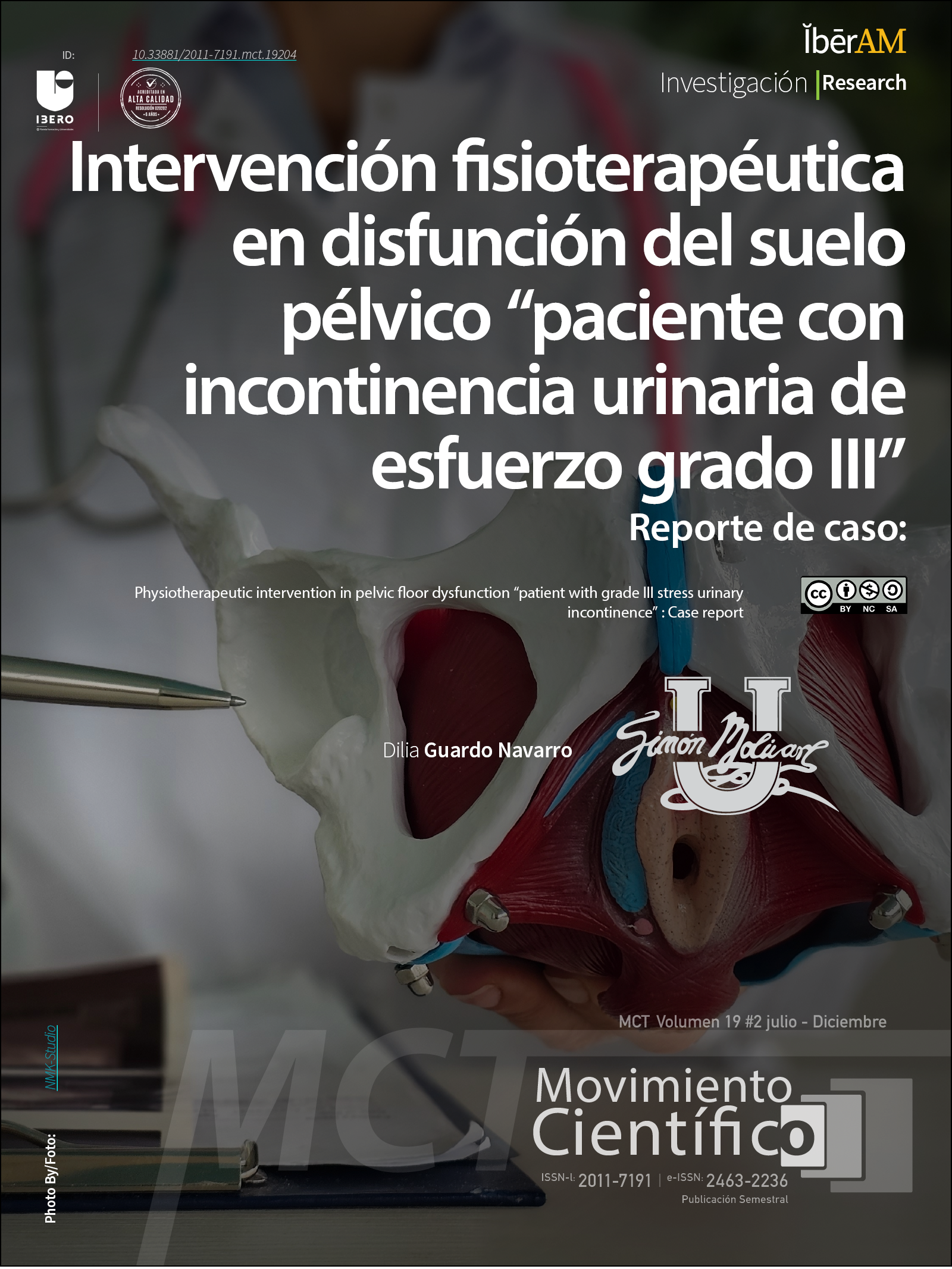Physiotherapy intervention for pelvic floor dysfunction in a patient with grade III stress urinary incontinence.
Intervención fisioterapéutica en disfunción del suelo pélvico “paciente con incontinencia urinaria de esfuerzo grado III” Case report
Main Article Content
Stress urinary incontinence (SUI) is a common
dysfunction in women that significantly affects
their quality of life (Milsom & Gyhagen, 2019). This
study aims to describe the rehabilitation process
of a patient with severe SUI and its functional
outcomes. Method: A case study was conducted on
a 58-year-old female teacher with a history of basal
cell carcinoma, moderate obesity, hysterectomy, and
grade I cystocele. She presented with severe urine
loss and daily use of disposable protectors. Physical
evaluation revealed hypertonic diaphragmatic
tone, 3 cm abdominal diastasis, positive perineal
descent test, and hypotonic abdominal muscles. A
therapeutic plan was established based on habit
modification, pelvic floor strengthening with Emsella
chair and biofeedback, as well as home-based
Kegel and hypopressive exercises (Dumoulin et al.,
2014). Results: After three months of therapy, the
patient showed significant improvement, reducing
the use of protectors, eliminating dyspareunia and
nocturnal leakage, and improving her quality of life.
Conclusion: This case highlights the effectiveness of
physiotherapy in SUI rehabilitation, achieving positive
functional outcomes and improving the patient’s
well-being.
Publication Facts
Reviewer profiles N/A
Author statements
Indexed in
-
—
- Academic society
- N/A
- Publisher
- Bogotá: Corporación Universitaria Iberoamericana
Article Details
Abrams, P., Cardozo, L., Khoury, S., & Wein, A. (2013). Incontinence: 5th International Consultation on Incontinence. Health Publication Ltd.
Berghmans, L. C., Hendriks, H. J., de Bie, R. A., & van Waalwijk van Doorn, E. S. (1998). Conservative treatment of stress urinary incontinence in women: A systematic review of randomized clinical trials. British Journal of Urology, 82(2), 181–191.
Bø, K., & Sherburn, M. (2005). Evaluation of female pelvic‑floor muscle function and strength. Physical Therapy, 85(3), 269–282.
Byles, J. E., Millar, C. J., Sibbritt, D. W., & Halcomb, E. J. (2009). Living with urinary incontinence: A longitudinal study of older women. Age and Ageing, 38(3), 333–338.
Coyne, K. S., Wein, A., Nicholson, S., Kvasz, M., Chen, C. I., & Milsom, I. (2014). Economic burden of urgency urinary incontinence in the United States: A systematic review. Journal of Managed Care Pharmacy, 20(2), 130–140.
Dumoulin, C., Hay‑Smith, E. J., & Habée‑Séguin, G. M. (2014). Pelvic floor muscle training versus no treatment, or inactive control treatments, for urinary incontinence in women. Cochrane Database of Systematic Reviews, (5), Article CD005654.
International Continence Society. (2018). ICS Fact Sheets. https://www.ics.org
Lo, T., Ho, D., Fan, N., Lau, K., & Chan, S. (2017). Pelvic floor muscle training with or without electrotherapy for stress urinary incontinence: A randomized controlled trial. Obstetrics & Gynecology, 129(4), 779–786.
Milsom, I., Altman, D., Cartwright, R., Lapitan, M. C., Nelson, R., Sjöström, S., et al. (2017). Epidemiology of urinary (UI) and faecal (FI) incontinence and pelvic organ prolapse (POP). In P. Abrams, L. Cardozo, A. Wagg, & A. Wein (Eds.), Incontinence (6th ed., pp. 15–108). International Continence Society.
Milsom, I., & Gyhagen, M. (2019). The prevalence of urinary incontinence. Climacteric, 22(3), 217–222.
Minassian, V. A., Stewart, W. F., & Wood, G. C. (2008). Urinary incontinence in women: Variation in prevalence estimates and risk factors. Obstetrics & Gynecology, 111(2 Pt 1), 324–331.
Neumann, P., Amaro, J. L., Oliveira, E., Natalin, R., & Kenfack, M. (2005). Biofeedback improves pelvic floor muscle training for female urinary incontinence: A randomized controlled trial. International Urogynecology Journal, 16(6), 441–448.
Palacios, S., Ramírez, M., Lilie, M., & Barahona, S. (2023). Electromagnetoterapia en el suelo pélvico de la mujer. De la teoría a la práctica clínica. Instituto Palacios de Salud y Medicina de la Mujer.
Walker, C. (2013). Fisioterapia en obstetricia y uroginecología (2nd ed.). Masson.














